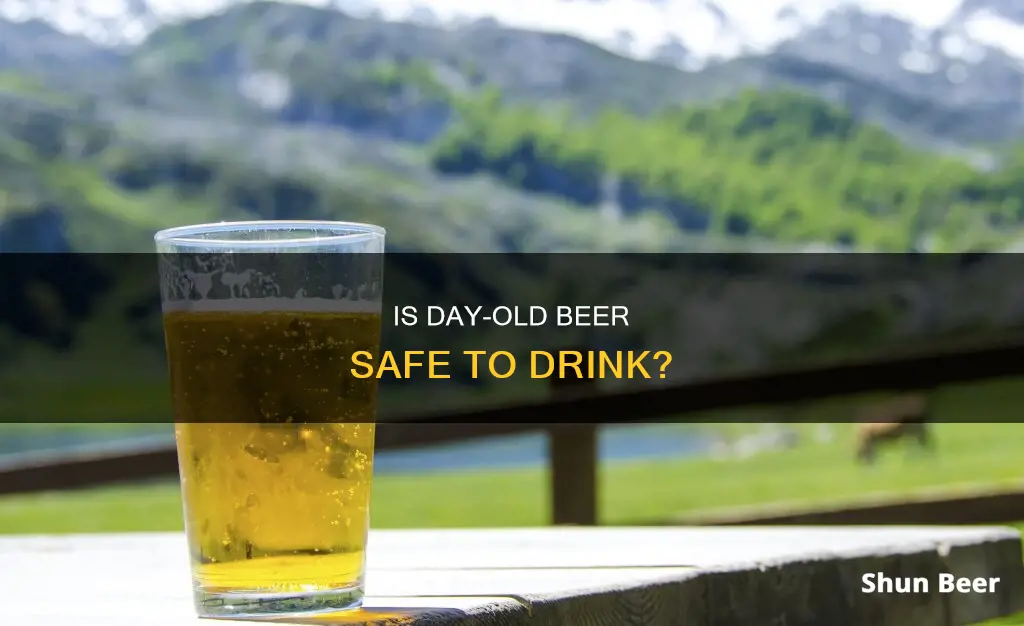
Beer is a popular alcoholic beverage with a variety of types, from lager to stout. But what happens if you don't finish a bottle or can and leave it for a day or two? Can you drink day-old beer? The short answer is yes, it is generally safe to consume day-old beer, but there are a few things to keep in mind. Firstly, beer is susceptible to oxidation, which can affect its taste and quality. Beer is best consumed within a day or two of opening to avoid significant changes in flavour. Additionally, beer should be stored in a cool, dark place to prevent spoilage and maintain optimal taste.
| Characteristics | Values |
|---|---|
| Drinking a day old beer | Safe, but may not taste good |
| Beer expiration | Beer rarely expires, but the quality might drop |
| Beer storage | Store beer in a cool, dark place |
| Opened beer | Should be consumed within a day or two |
| Beer taste | Becomes flat and stale after opening |
| Beer spoilage | Check for changes in colour, smell, and taste |
What You'll Learn

Beer doesn't improve with age like wine
Beer is a popular alcoholic beverage, but it is important to know whether and how long it can be stored. Unlike wine, beer does not improve with age. In fact, fresh beer is generally better. This is because the volatile compounds that make up a beer's flavour will change and often deplete over time, while the proteins that give it body will deteriorate, and oxidization will slowly take hold. Beers with a strong hop aroma are best consumed early, as these compounds will be most available soon after brewing.
However, some beers can be aged for a few months, or even years. Aging beer is a gamble, as there is a risk that the structure and character of the beer will deteriorate rather than improve. Beers with a higher alcohol content, of at least 7-9% ABV or more, are more suitable for aging, as they tend to have more complex flavours. Beers fermented with certain microbes associated with wild beer styles (lactobacillus, pediococcus, and brettanomyces) also have a better chance of improving with age.
When aging beer, it is important to store it in a dark, cool place, such as a basement or garage, where it is free from sunlight. UV rays can cause the beer to become "skunked" or develop off-flavours. Consistency of temperature is also important, and the ideal storage temperature is around 50 to 60 degrees Fahrenheit.
A well-aged beer will have a less intense flavour but more complex notes. It is important to note that whether an aged beer is considered better is subjective and depends on individual preferences. Some people prefer the intense and edgy flavours of a fresh beer, while others may enjoy the more nuanced flavours of an aged beer. Ultimately, the decision to age beer comes down to personal preference, and there is no definitive answer to whether a beer will improve with age.
Beer at Work: Is It Legal?
You may want to see also

Beer is best consumed within the first few months after bottling
Homebrewed beer, in particular, continues to evolve in flavour over time. It tends to improve for about one to two months after bottling, remains steady for several months, and then starts to deteriorate and turn stale after about a year. The flavour may continue to evolve and improve for a few months after bottling, but it will eventually decline in quality.
The yeast in bottled beer needs a few days to consume the sugar, and then a little more time is required for the beer to absorb the carbon dioxide fully. This process can take about two weeks, and the beer may taste muted or unbalanced until it has settled. Therefore, it is recommended to wait at least two weeks before drinking freshly bottled beer to allow for proper carbonation and flavour development.
Additionally, the storage conditions can impact the shelf life of beer. Beer should be stored in a cool, dark place, as exposure to light and heat can cause it to become skunky and stale more quickly. Proper storage can help maintain the quality of the beer for a few months after bottling.
In summary, while beer can be safely consumed past a few months, drinking it within this timeframe will ensure optimal flavour and freshness.
Beer Trading: How Does It Work?
You may want to see also

Beer can be stored for up to half a year if unopened
Beer is a popular alcoholic beverage, and it is important to know how long it can be stored for, especially if you are a beer enthusiast. Beer can be stored for up to half a year if unopened, but this depends on the type of beer and the storage conditions.
Firstly, the kind of beer matters. Beers with low alcohol content can last at least half a year if unopened, whereas vintage beers like ales, lambics, or stouts have a high alcohol content and are made to last a few years. In fact, producers of vintage beers recommend storing them for at least a year or two before opening, allowing the beer to age and develop its distinct taste.
Secondly, storage conditions play a crucial role in preserving the quality of unopened beer. Beer should be stored in a cool, dark place, away from direct sources of heat or light. The ideal temperature range is between 45°F and 55°F, which is colder than typical room temperature but warmer than a refrigerator. If stored at room temperature, unopened beer will generally stay at its best quality for about 4 to 6 months. However, if stored in a refrigerator, it can last for about 6 to 8 months.
It is worth noting that the colour of the bottle or can also matters. Beer in dark bottles or cans is better protected from light exposure, which can cause a skunky taste. Green bottles offer less protection, and clear bottles offer the least.
While unopened beer can be stored for an extended period, it is important to remember that its flavour will gradually degrade over time. Additionally, once the beer is opened, it should be consumed within a day or two, as it will start to go flat and stale.
Drinking Beer While Driving in Victoria: What's Allowed?
You may want to see also

Beer should be stored in a cool, dark place
Beer is the world's third most popular drink, but many people don't realise that it can spoil and should be stored correctly. Beer should be stored in a cool, dark place, such as a pantry or cupboard, and kept away from direct sunlight and heat sources. The temperature of stored beer should be between 45 and 55 degrees Fahrenheit, and ideally between 50 and 55 degrees Fahrenheit (10-13°C). Beer can also be stored in the refrigerator, where it will last for up to eight months.
Storing beer in a cool, dark place is important for several reasons. Firstly, beer is susceptible to light exposure, which can cause it to become "skunky" and develop an unpleasant taste and odour. This is due to a chemical reaction between UV rays and the hops in the beer, which causes permanent damage. Beer is often sold in dark bottles to protect it from light, but it is still recommended to store beer in a dark place, such as a pantry or cupboard, to prevent sunlight from reaching it.
Secondly, heat can cause serious damage to beer. High temperatures can cause the beer to spoil and affect its flavour, colour, and consistency. Beer stored in a hot car, for example, will only last a few days, whereas beer stored in the refrigerator can last for up to a year or more.
Finally, exposure to oxygen can alter the taste of beer. Storing beer upright can help to minimise contact with oxygen and slow down the oxidation process, which can affect the flavour and cause the beer to become stale.
By storing beer in a cool, dark place, you can help preserve its freshness, flavour, and quality, and prevent it from spoiling.
Honey's Magic in Beer: The Science Behind It
You may want to see also

Beer can be drunk past its best before date but may not taste good
Beer is a popular alcoholic beverage, but it's not always clear whether it expires or how long it lasts. Beer can be drunk past its "best before" date and is unlikely to be unsafe, but it may not taste good.
Firstly, it's important to note that the answer depends on the kind of beer. Normal beers, with low alcohol content, can last at least half a year if unopened, as long as they are stored properly. Some vintage beers, such as ales, lambics, or stouts, have high alcohol content and are made to last a few years. In fact, producers of these beers often recommend storing them for at least a year or two before opening to allow the beer to age and develop its distinct taste.
Once a beer is opened, it should ideally be consumed within a day or two. After that, the beer will most likely be flat and stale, and its taste will be far from what is expected. However, it is still safe to drink and may not be an issue for those who are less concerned with taste.
Beer doesn't expire in the sense that it will make you sick, but its quality will gradually decline over time. The higher the alcohol content, the less concerned you need to be with the use-by date. Beers with a greater amount of hops and a higher alcohol content (usually 9% or more) are brewed specifically for aging and can withstand the process without losing their flavour.
Additionally, exposure to light, high temperatures, and oxygen can accelerate the aging process, leading to undesirable flavours. To maximise the shelf life of beer, it should be stored in a cool, dark place, away from direct sources of heat or light.
Beer and Farxiga: What You Need to Know
You may want to see also
Frequently asked questions
Yes, it is safe to drink a day-old beer. However, it may not taste as good as a freshly opened beer.
Unopened beers with low alcohol content can last at least half a year if stored properly. Vintage beers like ales, lambics, or stouts have high alcohol content and are made to last a few years. In fact, producers of these beers recommend storing them for at least a year or two before opening.
Beer should be stored in a cool, dark place, away from direct sources of heat or light. Beer is often sold in dark bottles to protect it from light, as exposure to light can cause beer to become skunky.
Beer will not be unsafe to drink after its "best before" date, but it may not taste as good. The higher the alcohol content of the beer, the less you need to be concerned with the use-by date.







